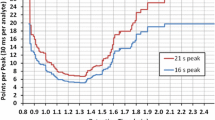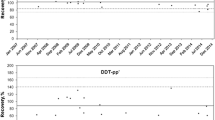Abstract
Direct analysis of fruit and vegetable surfaces is an important tool for in situ detection of food contaminants such as pesticides. We tested three different ways to prepare samples for the qualitative desorption electrospray ionization mass spectrometry (DESI-MS) analysis of 32 pesticides found on nine authentic fruits collected from food control. Best recovery rates for topically applied pesticides (88%) were found by analyzing the surface of a glass slide which had been rubbed against the surface of the food. Pesticide concentration in all samples was at or below the maximum residue level allowed. In addition to the high sensitivity of the method for qualitative analysis, quantitative or, at least, semi-quantitative information is needed in food control. We developed a DESI-MS method for the simultaneous determination of linear calibration curves of multiple pesticides of the same chemical class using normalization to one internal standard (ISTD). The method was first optimized for food extracts and subsequently evaluated for the quantification of pesticides in three authentic food extracts. Next, pesticides and the ISTD were applied directly onto food surfaces, and the corresponding calibration curves were obtained. The determination of linear calibration curves was still feasible, as demonstrated for three different food surfaces. This proof-of-principle method was used to simultaneously quantify two pesticides on an authentic sample, showing that the method developed could serve as a fast and simple preselective tool for disclosure of pesticide regulation violations.

Multiple pesticide residues were detected and quantified in-situ from an authentic set of food items and extracts in a proof of principle study




Similar content being viewed by others
References
UN (United Nations). Department of Economic and Social Affairs. World Population Prospects: The 2012 Revision. New York: United Nations; 2013.
Oerke EC. Crop losses to pests. J Agric Sci. 2006;144:31–43. doi:10.1017/s0021859605005708.
Industrieverband Agrar Jahresbericht 2013/2014. Frankfurt am Main; 2014.
DeLorenzo ME, Scott GI, Ross PE. Toxicity of pesticides to aquatic microorganisms: a review. Environ Toxicol Chem. 2001;20(1):84–98. doi:10.1002/etc.5620200108.
Hamilton D, Ambrus A, Dieterle R, Felsot A, Harris C, Petersen B, et al. Pesticide residues in food—acute dietary exposure. Pest Manag Sci. 2004;60(4):311–39. doi:10.1002/ps.865.
Dung Tri P, Connell D, Miller G, Rutherford S, Chu C. Pesticide regulations and farm worker safety: the need to improve pesticide regulations in Viet Nam. Bull World Health Organ. 2012;90(6):468–73. doi:10.2471/blt.11.096578.
Azaroff LS, Neas LM. Acute health effects associated with nonoccupational pesticide exposure in rural El Salvador. Environ Res. 1999;80(2):158–64. doi:10.1006/enrs.1998.3878.
European Union. Regulation (EC) No 396/2005.
European Union. http://ec.europa.eu/food/plant/pesticides/eu-pesticides-database/public/?event=homepage&language=EN.
European Union. Regulation (EC) No. 1107/2009. 2009. http://eur-lex.europa.eu/legal-content/EN/TXT/?uri=CELEX:32009R1107.
Heinzler M, Gerlach D, Brunn H. New border control system for food originating from third world countries. Environ Sci Eur. 2011;23(1):1–6. doi:10.1186/2190-4715-23-14.
Farre M, Barcelo D. Analysis of emerging contaminants in food. TrAC Trends Anal Chem. 2013;43:240–53. doi:10.1016/j.trac.2012.12.003.
Nunez O, Gallart-Ayala H, Martins CPB, Lucci P. New trends in fast liquid chromatography for food and environmental analysis. J Chromatogr A. 2012;1228:298–323. doi:10.1016/j.chroma.2011.10.091.
Makarov A. Electrostatic axially harmonic orbital trapping: a high-performance technique of mass analysis. Anal Chem. 2000;72(6):1156–62.
Anastassiades M, Lehotay SJ, Stajnbaher D, Schenck FJ. Fast and easy multiresidue method employing acetonitrile extraction/partitioning and “dispersive solid-phase extraction” for the determination of pesticide residues in produce. J AOAC Int. 2003;86(2):412–31.
Cody RB, Laramee JA, Durst HD. Versatile new ion source for the analysis of materials in open air under ambient conditions. Anal Chem. 2005;77(8):2297–302. doi:10.1021/ac050152j.
Harper J, Charipar N, Mulligan C, Zhang X, Cooks R, Ouyang Z. Low-temperature plasma probe for ambient desorption ionization. Anal Chem. 2008;80(23):9097–104. doi:10.1021/ac801641a|10.1021/ac801641a.
Trimpin S, Inutan ED, Herath TN, McEwen CN. Laserspray ionization, a new atmospheric pressure MALDI method for producing highly charged gas-phase ions of peptides and proteins directly from solid solutions. Mol Cell Proteomics. 2010;9(2):362–7. doi:10.1074/mcp.M900527-MCP200.
Takats Z, Wiseman JM, Gologan B, Cooks RG. Mass spectrometry sampling under ambient conditions with desorption electrospray ionization. Science. 2004;306(5695):471–3.
Takats Z, Wiseman J, Cooks R. Ambient mass spectrometry using desorption electrospray ionization (DESI): instrumentation, mechanisms and applications in forensics, chemistry, and biology. J Mass Spectrom. 2005;40(10):1261–75.
Katona M, Denes J, Skoumal R, Toth M, Takats Z. Intact skin analysis by desorption electrospray ionization mass spectrometry. Analyst. 2011;136(4):835–40. doi:10.1039/c0an00688b.
Thunig J, Hansen SH, Janfelt C. Analysis of secondary plant metabolites by indirect desorption electrospray ionization imaging mass spectrometry. Anal Chem. 2011;83(9):3256–9. doi:10.1021/ac2004967.
Kauppila TJ, Wiseman JM, Ketola RA, Kotiaho T, Cooks RG, Kostiainen R. Desorption electrospray ionization mass spectrometry for the analysis of pharmaceuticals and metabolites. Rapid Commun Mass Spectrom. 2006;20(3):387–92. doi:10.1002/rcm.2304.
Cotte-Rodriguez I, Hernandez-Soto H, Chen H, Cooks RG. In situ trace detection of peroxide explosives by desorption electrospray ionization and desorption atmospheric pressure chemical ionization. Anal Chem. 2008;80(5):1512–9. doi:10.1021/ac7020085.
Garcia-Reyes JF, Jackson AU, Molina-Diaz A, Cooks RG. Desorption electrospray ionization mass spectrometry for trace analysis of agrochemicals in food. Anal Chem. 2009;81(2):820–9. doi:10.1021/ac802166v.
Cajka T, Riddellova K, Zomer P, Mol H, Hajslova J. Direct analysis of dithiocarbamate fungicides in fruit by ambient mass spectrometry. Food Addit Contam Part A. 2011;28(10):1372–82. doi:10.1080/19440049.2011.590456.
Zhang X-Z, Li C-J, Chen S-S, Li X-J, Han H, Ma X-D. Direct determination of atrazine residue on Chinese cabbage leaf using desorption electrospray ionization-tandem mass spectrometry and its application for diagnosing atrazine drift phytotoxicity. J AOAC Int. 2009;92(5):1587–92.
Berchtold C, Muller V, Meier L, Schmid S, Zenobi R. Direct detection of chlorpropham on potato skin using desorption electrospray ionization. J Mass Spectrom. 2013;48(5):587–93. doi:10.1002/jms.3197.
Hernandez-Borges J, Cabrera JC, Rodriguez-Delgado MA, Hernandez-Suarez EM, Sauco VG. Analysis of pesticide residues in bananas harvested in the Canary Islands (Spain). Food Chem. 2009;113(1):313–9. doi:10.1016/j.foodchem.2008.07.042.
Xu X-M, Yu S, Li R, Fan J, Chen S-H, Shen H-T, et al. Distribution and migration study of pesticides between peel and pulp in grape by online gel permeation chromatography-gas chromatography/mass spectrometry. Food Chem. 2012;135(1):161–9. doi:10.1016/j.foodchem.2012.04.052.
Edison SE, Lin LA, Gamble BM, Wong J, Zhang K. Surface swabbing technique for the rapid screening for pesticides using ambient pressure desorption ionization with high-resolution mass spectrometry. Rapid Commun Mass Spectrom. 2011;25(1):127–39. doi:10.1002/rcm.4831.
Edison SE, Lin LA, Parrales L. Practical considerations for the rapid screening for pesticides using ambient pressure desorption ionisation with high-resolution mass spectrometry. Food Addit Contam Part A. 2011;28(10):1393–404. doi:10.1080/19440049.2011.596165.
Takats Z, Wiseman JM, Gologan B, Cooks RG. Electrosonic spray ionization. A gentle technique for generating folded proteins and protein complexes in the gas phase and for studying ion—molecule reactions at atmospheric pressure. Anal Chem. 2004;76(14):4050–8. doi:10.1021/ac049848m.
Albert A, Kramer A, Scheeren S, Engelhard C. Rapid and quantitative analysis of pesticides in fruits by QuEChERS pretreatment and low-temperature plasma desorption/ionization orbitrap mass spectrometry. Anal Methods. 2014;6(15):5463–71. doi:10.1039/c4ay00103f.
Katajamaa M, Oresic M. Data processing for mass spectrometry-based metabolomics. J Chromatogr A. 2007;1158(1–2):318–28. doi:10.1016/j.chroma.2007.04.021.
De Ridder F, Pintelon R, Schoukens J, Navez J, Andre L, Dehairs F. An improved multiple internal standard normalisation for drift in LA-ICP-MS measurements. J Anal At Spectrom. 2002;17(11):1461–70. doi:10.1039/b207715a.
Doue M, Dervilly-Pinel G, Gicquiau A, Pouponneau K, Monteau F, Le Bizec B. High throughput identification and quantification of anabolic steroid esters by atmospheric solids analysis probe mass spectrometry for efficient screening of drug preparations. Anal Chem. 2014;86:5649–55. doi:10.1021/ac501072g.
Clayton M, Amos ND, Banks NH, Morton RH. Estimation of apple fruit surface-area. N Z J Crop Hortic Sci. 1995;23(3):345–9.
Furness NH, Upadhyaya A, Upadhyaya MK. Comparison of three nondestructive methods for determination of vegetable surface area. Hortscience. 2002;37(3):550–3.
Nanita SC, Pentz AM, Bramble FQ. High-throughput pesticide residue quantitative analysis achieved by tandem mass spectrometry with automated flow injection. Anal Chem. 2009;81(8):3134–42. doi:10.1021/ac900226w.
Mol HGJ, van Dam RCJ. Rapid detection of pesticides not amenable to multi-residue methods by flow injection-tandem mass spectrometry. Anal Bioanal Chem. 2014;406(27):6817–25. doi:10.1007/s00216-014-7644-8.
Nanita SC, Kaldon LG. Emerging flow injection mass spectrometry methods for high-throughput quantitative analysis. Anal Bioanal Chem. 2016;408(1):23–33. doi:10.1007/s00216-015-9193-1.
Gerbig S, Brunn HE, Spengler B, Schulz S. Spatially resolved investigation of systemic and contact pesticides in plant material by desorption electrospray ionization mass spectrometry imaging (DESI-MSI). Anal Bioanal Chem. 2015;407(24):7379–89. doi:10.1007/s00216-015-8900-2.
Acknowledgements
Financial support by the State of Hesse (LOEWE Research Focus “Ambiprobe”) and by the Justus Liebig University (research grant for junior academic staff) is gratefully acknowledged.
Author information
Authors and Affiliations
Corresponding author
Ethics declarations
Conflict of interest
The authors declare that they have no conflict of interest.
Electronic supplementary material
Below is the link to the electronic supplementary material.
ESM 1
(PDF 199 kb)
Rights and permissions
About this article
Cite this article
Gerbig, S., Stern, G., Brunn, H.E. et al. Method development towards qualitative and semi-quantitative analysis of multiple pesticides from food surfaces and extracts by desorption electrospray ionization mass spectrometry as a preselective tool for food control. Anal Bioanal Chem 409, 2107–2117 (2017). https://doi.org/10.1007/s00216-016-0157-x
Received:
Revised:
Accepted:
Published:
Issue Date:
DOI: https://doi.org/10.1007/s00216-016-0157-x




